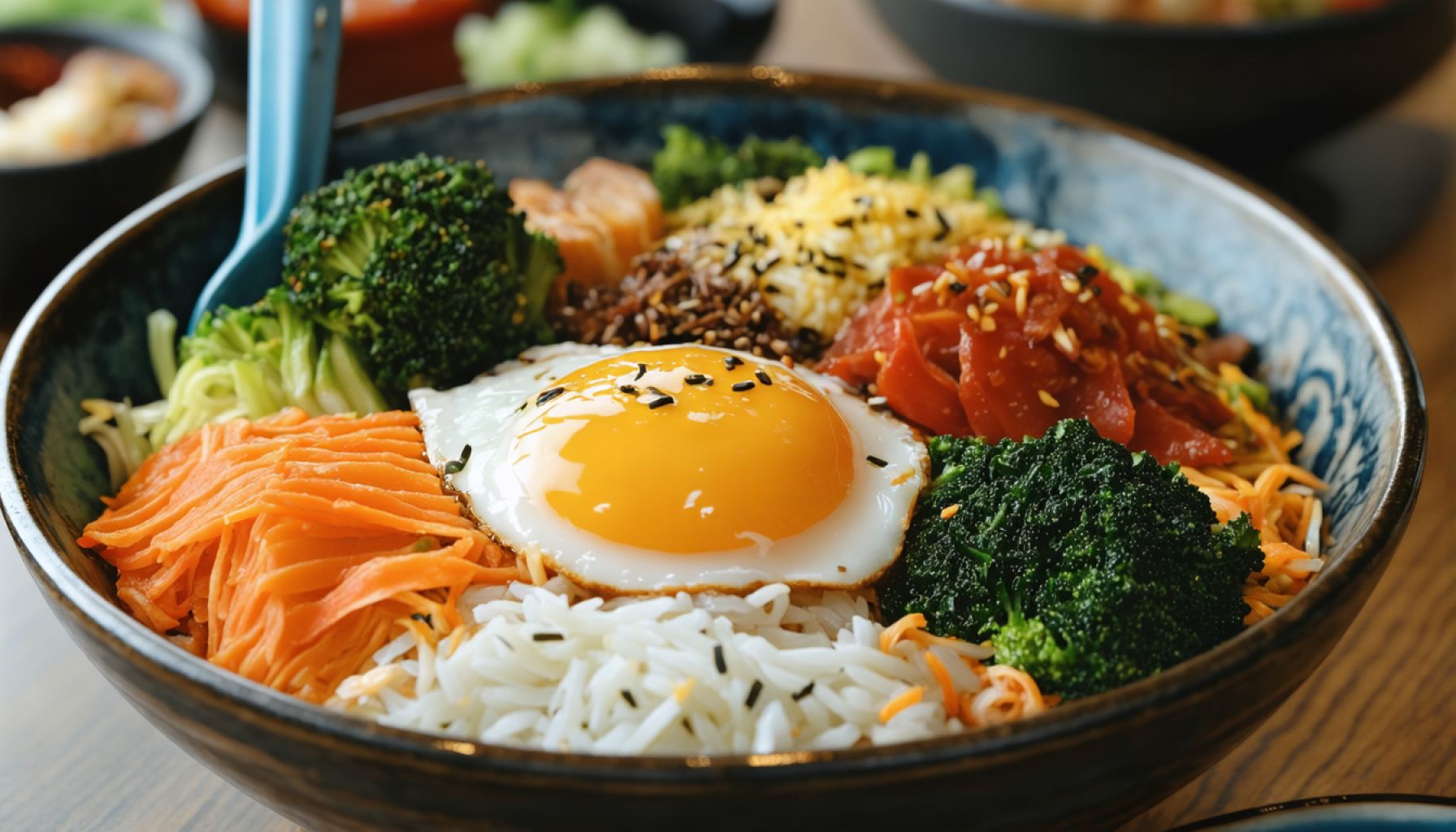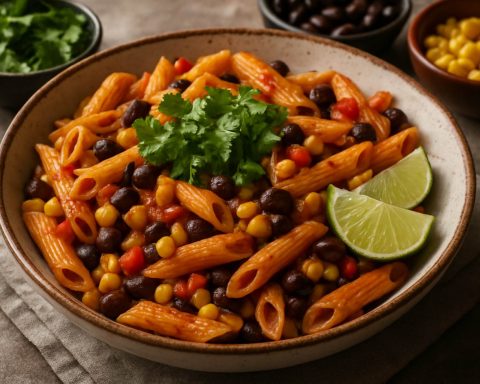Discover the delightful world of Bibimbap, a vibrant and harmonious Korean dish that’s as beautiful as it is delicious. Originating from Korea, Bibimbap translates to “mixed rice with meat and assorted vegetables.” This dish embodies the spirit of Korean cuisine by incorporating a colorful array of ingredients that come together to create a symphony of flavors and textures. Ideal for family gatherings or a delicious meal for one, Bibimbap is perfect for any occasion where taste and presentation are equally important.
Ingredients:
– 2 cups of cooked white rice
– 200g of beef strips
– 1 tablespoon sesame oil
– 1 tablespoon soy sauce
– 2 cloves of garlic, minced
– 2 carrots, julienned
– 1 zucchini, sliced
– A handful of spinach
– Bean sprouts
– 1 egg
– Gochujang (Korean red chili paste) to taste
– Sesame seeds for garnish
Instructions:
1. Prepare the beef: Marinate it in sesame oil, soy sauce, and minced garlic for at least 30 minutes.
2. Cook the vegetables: Sauté carrots, zucchini, spinach, and bean sprouts individually. Season them with a pinch of salt.
3. Cook the beef: In a hot pan, cook the marinated beef until it’s fully cooked.
4. Fry the egg: Cook it sunny side up for a visually appealing touch.
5. Assemble your Bibimbap: Start with a bed of rice. Arrange your sautéed vegetables and beef on top, ensuring a burst of colors.
6. Finalize your dish: Add the fried egg on top, drizzle with gochujang, and garnish with sesame seeds.
Enjoy the ultimate Bibimbap experience, immersing yourself in Korea’s rich culinary tradition!
The Health Boosting Benefits of Bibimbap
Bibimbap, a signature dish from Korea, is not only a feast for the eyes with its colorful presentation but also a treasure trove of nutritional benefits. This vibrant meal, with its perfect blend of various ingredients, caters to health-conscious foodies and those seeking an authentic taste of Korean culture. Let’s explore the health benefits derived from the wholesome ingredients that come together in this delightful dish.
Rice: The Balanced Base
The foundation of Bibimbap, typically made with white rice, provides a good source of energy. Rich in carbohydrates, it serves as a quick and efficient energy source for the body. Additionally, rice is low in saturated fat and cholesterol, making it a heart-healthy addition to the meal.
Lean Beef: Protein and Iron
The inclusion of beef strips contributes a substantial amount of protein to Bibimbap, essential for muscle repair and growth. Beef is also a noteworthy source of iron, which is crucial for producing red blood cells and preventing anemia. Marinating the beef in sesame oil and soy sauce not only enhances its flavor but also holds its nutritional worth.
Sesame Oil: Heart-Healthy Fats
Sesame oil, used to marinate the beef, is rich in monounsaturated and polyunsaturated fats. These healthy fats help reduce bad cholesterol levels, decreasing the risk of heart disease. Additionally, sesame oil contains antioxidants which support overall health.
Colorful Vegetables: Packed with Vitamins and Minerals
The assorted vegetables in Bibimbap, including carrots, zucchini, spinach, and bean sprouts, are packed with essential vitamins and minerals. Carrots are abundant in beta-carotene, supporting eye health. Zucchini provides vitamin C, which aids in immune function, while spinach is rich in iron and magnesium, critical for maintaining energy levels. Bean sprouts add fiber and a range of B vitamins, contributing to digestive health and metabolic processes.
Egg: Complete Protein
The sunny side up egg placed atop the dish is an excellent source of high-quality protein. Eggs supply all nine essential amino acids and are loaded with vital nutrients like vitamin B12, essential for nerve function and red blood cell production.
Gochujang: Metabolism Booster
Gochujang, the Korean red chili paste, not only imparts a spicy kick to Bibimbap but also offers health benefits through its capsaicin content. Capsaicin is known to boost metabolism and promote fat loss. Additionally, gochujang contains probiotics, aiding in gut health.
Sesame Seeds: Nutrient Dense Garnish
Lastly, sesame seeds sprinkled atop the dish are small but mighty. They are a rich source of calcium, necessary for strong bones, and contain sesamin, a lignan that helps protect the liver and reduce inflammation.
In conclusion, Bibimbap is more than just a culinary delight; it’s a harmonious blend of ingredients that together offer a multitude of health benefits. Whether you’re enjoying it at a family gathering or savoring it solo, Bibimbap nourishes not just your body, but also your soul by connecting you to the vibrant flavors of Korean tradition.
Unlock the Secrets of Making Perfect Bibimbap at Home: A Culinary Masterpiece
Exploring the Depths of Bibimbap: More Than Just a Mixed Rice Dish
Bibimbap, a staple of Korean cuisine, is renowned for its vibrant presentation and harmonious combination of flavors. As more people globally embrace this culinary gem, it is evolving, with innovative twists enhancing its traditional allure. This article delves into aspects of Bibimbap not commonly discussed, covering trends, innovations, and practical insights for enthusiasts keen to master this dish at home.
Emerging Trends and Cultural Influence
As Bibimbap gains popularity internationally, there is an increasing trend of adapting the dish to include locally sourced ingredients which cater to diverse dietary requirements. For instance, the traditional beef can be substituted with tofu or tempeh, inviting vegetarians and vegans to savor this Korean delight without compromising on taste.
Innovative Variations and Ingredients
Modern adaptations have seen chefs experimenting with different grain bases, using quinoa or cauliflower rice to provide a healthier or gluten-free option. Moreover, the classic fried egg can be replaced with poached or scrambled eggs, customizing the dish’s texture and presentation further.
Pros and Cons of Homemade Versus Restaurant Bibimbap
Pros:
– Customization: Homemade Bibimbap allows for personalized ingredient selection and portion control.
– Cost-effective: Creating Bibimbap at home typically costs less than dining out.
– Nutritional Control: Home preparation enables healthier ingredient choices without preservatives.
Cons:
– Time-Consuming: Preparing each component separately can be time-intensive.
– Ingredient Availability: Specialized ingredients such as gochujang might not be readily available in all areas.
Tips for Achieving Restaurant-Quality Bibimbap at Home
1. Use Fresh Ingredients: Freshness is key to achieving the authentic taste and vibrant presentation of Bibimbap.
2. Marinate Adequately: Allow ample time for the beef or its substitute to marinate, ensuring deep, rich flavors.
3. Presentation Matters: Arrange the ingredients meticulously, ensuring a colorful and appealing layout reflective of its traditional aesthetic.
Security Aspects and Preparation Safety
When preparing Bibimbap at home, food safety should be a priority. Ensure raw ingredients are cleaned thoroughly before cooking, and practice proper kitchen hygiene to prevent cross-contamination, especially when handling raw meat and egg products.
Sustainability in Bibimbap Preparation
With increasing awareness of sustainability, opting for organic vegetables and ethically sourced meats can make preparing Bibimbap environmentally friendly. Utilizing seasonal produce not only reduces carbon footprint but often enhances the dish’s flavor profile.
Bibimbap’s Future and Market Predictions
As global palates lean towards more authentic and health-conscious choices, Bibimbap is anticipated to continue rising in popularity. Its versatility, nutritional balance, and aesthetic appeal position it favorably within international culinary circles, making it a dish that transcends borders and flavors.
For more insights into Korean culinary traditions and innovative recipes, visit the official website of Visit Korea.








